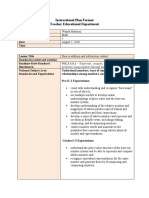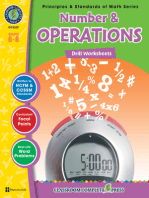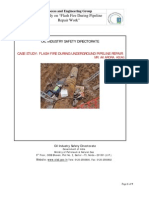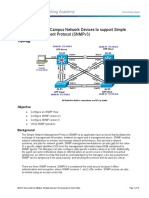Ac Maths Yr4 Plan
Ac Maths Yr4 Plan
Uploaded by
Dinusha BRITTOCopyright:
Available Formats
Ac Maths Yr4 Plan
Ac Maths Yr4 Plan
Uploaded by
Dinusha BRITTOCopyright
Available Formats
Share this document
Did you find this document useful?
Is this content inappropriate?
Copyright:
Available Formats
Ac Maths Yr4 Plan
Ac Maths Yr4 Plan
Uploaded by
Dinusha BRITTOCopyright:
Available Formats
Year 4 plan — Australian Curriculum: Mathematics
Implementation year: School name:
Year level description The proficiency strands Understanding, Fluency, Problem Solving and Reasoning are an integral part of mathematics content across the three content strands: Number and Algebra,
Measurement and Geometry, and Statistics and Probability. The proficiencies reinforce the significance of working mathematically within the content and describe how the content is explored or
developed. They provide the language to build in the developmental aspects of the learning of mathematics.
At this year level:
Understanding includes making connections between representations of numbers, partitioning and combining numbers flexibly, extending place value to decimals, using appropriate language to
communicate times and describing properties of symmetrical shapes
Fluency includes recalling multiplication tables, communicating sequences of simple fractions, using instruments to measure accurately, creating patterns with shapes and their transformations,
and collecting and recording data
Identify curriculum
Problem Solving includes formulating, modelling and recording authentic situations involving operations, comparing large numbers with each other, comparing time durations, and using properties
of numbers to continue patterns
Reasoning includes using generalising from number properties and results of calculations, deriving strategies for unfamiliar multiplication and division tasks, comparing angles, communicating
information using graphical displays and evaluating the appropriateness of different displays.
Achievement standard By the end of Year 4, students choose appropriate strategies for calculations involving multiplication and division. They recognise common equivalent fractions in familiar contexts and make
connections between fraction and decimal notations up to two decimal places. Students solve simple purchasing problems. They identify unknown quantities in number sentences. They describe
number patterns resulting from multiplication. Students compare areas of regular and irregular shapes using informal units. They solve problems involving time duration. They interpret information
contained in maps. Students identify dependent and independent events. They describe different methods for data collection and representation, and evaluate their effectiveness.
Students use the properties of odd and even numbers. They recall multiplication facts to 10 x 10 and related division facts. Students locate familiar fractions on a number line. They continue
number sequences involving multiples of single digit numbers. Students use scaled instruments to measure temperatures, lengths, shapes and objects. They convert between units of time.
Students create symmetrical shapes and patterns. They classify angles in relation to a right angle. Students list the probabilities of everyday events. They construct data displays from given or
collected data.
Source: Australian Curriculum, Assessment and Reporting Authority (ACARA), Australian Curriculum v3.0: Mathematics for Foundation–10, <www.australiancurriculum.edu.au/Mathematics/Curriculum/F-10>.
Term overview Term 1 Term 2 Term 3 Term 4
During this term students will: Exemplar unit: Shapes, area, angles and During this term students will: During this term students will:
recognise, represent, order and apply place symmetry in the environment revise and consolidate Terms 1 and 2 revise and consolidate Terms 1, 2 and 3
value of numbers up to tens of thousands During this term students will: concepts as required concepts as required
apply multiplication facts (2, 3, 4, 5, 10) revise and consolidate Term 1 concepts as apply place value to partition, rearrange apply place value to partition, rearrange
investigate fractions (count by halves, required and regroup numbers to at least tens of and regroup numbers to at least tens of
quarters and thirds) recognise, represent and order numbers up thousands thousands
investigate multiplication number patterns to tens of thousands apply multiplication and related division solve word problems for multiplication and
apply multiplication and related division facts (2, 3, 4, 5, 6, 7, 8, 9, 10) division, using a variety of strategies
Teaching and learning
investigate time and length
facts (2, 3, 4, 5, 6, 9, 10) use efficient written and mental strategies solve word problems related to money
revise and consolidate Year 3 concepts as
investigate properties of odd and even for multiplication and division (purchases and change)
required.
numbers apply place value of numbers to tenths and investigate the area of regular and irregular
investigate number sequences involving hundredths shapes
multiples (3, 4 ,6, 7, 8, 9) make connections between fractions and investigate volume
split and combine two-dimensional shapes decimals (equivalence) compare and classify angles
investigate the area of regular and irregular locate and represent fractions on a number explore everyday chance events
shapes line
investigate data collection methods and
compare and classify angles use addition and subtraction to find representations
investigate symmetry. unknown quantities
collect data, create and evaluate data
investigate mass, capacity and temperature displays.
investigate location (scale, legend,
direction)
explore chance
collect data, and create and evaluate data
displays.
Queensland Studies Authority January 2012 |
1
Aboriginal and Torres Mathematics provides opportunities for students to strengthen their appreciation and understanding of Aboriginal peoples and Torres Strait Islander peoples and their living cultures. Specific
Strait Islander perspectives content and skills within relevant sections of the curriculum can be drawn upon to encourage engagement with:
Aboriginal and Torres Strait Islander frameworks of knowing and ways of learning
Social, historical and cultural contexts associated with different uses of mathematical concepts in Australian Indigenous societies
Teaching and learning
Aboriginal peoples’ and Torres Strait Islander peoples’ contributions to Australian society and cultures.
Mathematics provides opportunities to explore aspects of Australian Indigenous knowing in connection to, and with guidance from, the communities who own them. Using a respectful inquiry
approach, students have the opportunity to explore mathematical concepts in Aboriginal and Torres Strait Islander lifestyles including knowledge of number, space, measurement and time.
Through these experiences, students have opportunities to learn that Aboriginal peoples and Torres Strait Islander peoples have sophisticated applications of mathematical concepts which may
be applied in other peoples’ ways of knowing.
General capabilities and Opportunities to engage with: Opportunities to engage with: Opportunities to engage with: Opportunities to engage with:
cross-curriculum priorities
Key to general capabilities and
Literacy Numeracy ICT capability Critical and creative thinking Ethical behaviour Personal and social capability Intercultural understanding
cross-curriculum priorities
Aboriginal and Torres Strait Islander histories and cultures Asia and Australia’s engagement with Asia Sustainability
Assessment A folio is a targeted selection of evidence of student learning and includes a range of responses to a variety of assessment techniques. A folio is used to make an overall on-balance judgment
For advice and guidelines on about student achievement and progress at appropriate points and informs the reporting process.
assessment, see
Term 1 Term 2 Term 3 Term 4
www.qsa.qld.edu.au
Week Assessment instrument Week Assessment instrument Week Assessment instrument Week Assessment instrument
1 Initial assessment 4 Modelling and problem-solving task 3–8 Modelling and problem-solving task: 4 Supervised assessment: Short
Identify Year 4 consolidation needs (Written) Using a map (Written) response (Written)
and learning goals (e.g. KWL, Explore symmetrical patterns in art Show compass points around the Solve problems related to
teacher/student conference). work. school on a map (treasure hunt). measurements and comparisons.
Develop assessment
4 Modelling and problem-solving task 6–8 Mathematical investigation: Journal 5 Supervised assessment: Short 7 Mathematical investigation: Graphic
(Spoken/signed) (Written) response (Written) organiser (Written)
Explore number patterns and Investigate shapes, area, angles Solve problems related to fractions. Collect and represent data of
properties. and symmetry in the environment. everyday chance events.
The assessment package Angles
and symmetry in the built
environment in the QSA
Assessment Bank could be used in
this unit.
6–7 Supervised assessment: Short 9 Supervised assessment: Short 8–9 Mathematical investigation (Written)
response (Written) response (Written) Investigate area, volume and angles.
Apply place value. Solve multiplication and division
problems.
8–9 Modelling and problem-solving task: QCATs: Identify the curriculum targeted by the QCAT and schedule its implementation
Demonstration (Spoken/signed) appropriate to the sequence of learning.
Explore time.
Moderation Teachers develop tasks and plan units. Teachers develop tasks and plan units. Teachers develop tasks and plan units. Teachers develop tasks and plan units.
and use feedback
Make judgments
Teachers co-mark tasks to ensure consistency Teachers identify A–E samples before marking Teachers identify A–E samples before marking Teachers co-mark tasks to ensure consistency
of judgments. tasks, and moderate to ensure consistency of the treasure hunt task, and moderate to of judgments.
judgments. ensure consistency of judgments. Curriculum leaders randomly sample folios to
Curriculum leaders randomly sample folios to Teachers moderate the QCATs to identify A–E check for consistency of teacher judgments.
check for consistency of judgments. samples to take to cluster moderation in Teachers participate in cluster moderation of
Term 4. the QCATs.
2 | Year 4 plan Australian Curriculum: Mathematics
Year 4 Mathematics: review for balance and coverage of content descriptions
Number and Algebra 1 2 3 4 Measurement and Geometry 1 2 3 4
Number and place value Using units of measurement
Investigate and use the properties of odd Use scaled instruments to measure and
and even numbers (ACMNA071) compare lengths, masses, capacities and
temperatures (ACMMG084)
Recognise, represent and order numbers to
at least tens of thousands (ACMNA072) Compare objects using familiar metric units of
area and volume (ACMMG290)
Apply place value to partition, rearrange and
regroup numbers to at least tens of Convert between units of time (ACMMG085)
thousands to assist calculations and solve
problems (ACMNA073)
Use am and pm notation and solve simple time
problems (ACMMG086)
Investigate number sequences involving Shape
multiples of 3, 4, 6, 7, 8, and 9 (ACMNA074)
Compare the areas of regular and irregular
Recall multiplication facts up to 10 × 10 and shapes by informal means (ACMMG087)
related division facts (ACMNA075)
Develop efficient mental and written
Compare and describe two dimensional shapes
that result from combining and splitting common
strategies and use appropriate digital
shapes, with and without the use of digital
technologies for multiplication and for
technologies (ACMMG088)
division where there is no remainder
(ACMNA076) Location and transformation
Fractions and decimals Use simple scales, legends and directions to
interpret information contained in basic maps
Investigate equivalent fractions used in (ACMMG090)
contexts (ACMNA077)
Count by quarters halves and thirds,
Create symmetrical patterns, pictures and
shapes with and without digital technologies
including with mixed numerals. Locate and
(ACMMG091)
represent these fractions on a number line
(ACMNA078) Geometric reasoning
Recognise that the place value system can Compare angles and classify them as equal to,
be extended to tenths and hundredths. greater than or less than a right angle
Make connections between fractions (ACMMG089)
and decimal notation (ACMNA079)
Money and financial mathematics
Solve problems involving purchases and the
calculation of change to the nearest five
cents with and without digital technologies
(ACMNA080)
Patterns and algebra
Explore and describe number patterns
resulting from performing multiplication
(ACMNA081)
Solve word problems by using number
sentences involving multiplication or division
where there is no remainder (ACMNA082)
Use equivalent number sentences involving
addition and subtraction to find unknown
quantities (ACMNA083)
Queensland Studies Authority January 2012 |
3
Statistics and Probability 1 2 3 4
Chance
Describe possible everyday events and order their chances of occurring (ACMSP092)
Identify everyday events where one cannot happen if the other happens (ACMSP093)
Identify events where the chance of one will not be affected by the occurrence of the other (ACMSP094)
Data representation and interpretation
Select and trial methods for data collection, including survey questions and recording sheets (ACMSP095)
Construct suitable data displays, with and without the use of digital technologies, from given or collected data. Include tables, column graphs and picture
graphs where one picture can represent many data values (ACMSP096)
Evaluate the effectiveness of different displays in illustrating data features including variability (ACMSP097)
Source: Australian Curriculum, Assessment and Reporting Authority (ACARA), Australian Curriculum v3.0: Mathematics for Foundation–10, <www.australiancurriculum.edu.au/Mathematics/Curriculum/F-10>.
4 | Year 4 plan Australian Curriculum: Mathematics
You might also like
- Curriculum Guide (Enhanced Math Grade 7-10) PDFDocument30 pagesCurriculum Guide (Enhanced Math Grade 7-10) PDFRonnel Mas81% (26)
- G9 U1 Math MYP Unit Planner 20182019Document6 pagesG9 U1 Math MYP Unit Planner 20182019Ayuu Nur AfifahNo ratings yet
- MYP 2 IntegersDocument6 pagesMYP 2 IntegersYomna SherifNo ratings yet
- Mipanda Yemazita (Noun Classes) : Mupanda 1Document33 pagesMipanda Yemazita (Noun Classes) : Mupanda 1Tboi Tboi100% (15)
- 4a Standard Costs and Analysis of VariancesDocument3 pages4a Standard Costs and Analysis of VariancesGina TingdayNo ratings yet
- Oregano CapstoneDocument16 pagesOregano CapstonePrincess Cloewie Ferrer100% (1)
- Math Unit 2016 456 R VassDocument17 pagesMath Unit 2016 456 R Vassapi-254665239No ratings yet
- Year 7 Plan - Australian Curriculum: Mathematics: Implementation Year: School Name: Year Level DescriptionDocument5 pagesYear 7 Plan - Australian Curriculum: Mathematics: Implementation Year: School Name: Year Level DescriptionLi NguyenNo ratings yet
- Year 5 - Western Australian Curriculum v8.1: Mathematics - Eden Hill Primary SchoolDocument3 pagesYear 5 - Western Australian Curriculum v8.1: Mathematics - Eden Hill Primary SchoolSaniaMalikNo ratings yet
- Ac Year 4 MathsDocument7 pagesAc Year 4 Mathsapi-230679736No ratings yet
- Mathematics Sequence of AchievementDocument3 pagesMathematics Sequence of AchievementMahadiNo ratings yet
- MathematicsDocument31 pagesMathematicskgotsoncengaNo ratings yet
- 2016NJSLS-M Grade4Document17 pages2016NJSLS-M Grade4Gene HermanNo ratings yet
- LAMP Mathematics Unpacked Competencies LRDocument136 pagesLAMP Mathematics Unpacked Competencies LREvelyn DEL ROSARIONo ratings yet
- Grade 8 Sorico Math Unit 3 2 2013-2014Document4 pagesGrade 8 Sorico Math Unit 3 2 2013-2014api-233707670No ratings yet
- Grade Three Indicators For The 2003 Mathematics Standard Course of StudyDocument46 pagesGrade Three Indicators For The 2003 Mathematics Standard Course of StudyNeha SinghNo ratings yet
- Grade 4 Unit 5 Scope and SequenceDocument11 pagesGrade 4 Unit 5 Scope and SequencereemaNo ratings yet
- Lesson 2Document6 pagesLesson 2Mitzi. SumaderoNo ratings yet
- Maths Unit - LengthDocument8 pagesMaths Unit - Lengthapi-426442865No ratings yet
- DLL - MG-Math - Week 2Document14 pagesDLL - MG-Math - Week 2Norren Mae CruzadaNo ratings yet
- 2016NJSLS-M Grade2Document16 pages2016NJSLS-M Grade2Gene HermanNo ratings yet
- Curriculum Design Instructional PlanDocument4 pagesCurriculum Design Instructional PlanWanda MounierNo ratings yet
- Ubd Place Value Unit - : Brief Summary of Unit (Including Curricular Context and Unit Goals)Document10 pagesUbd Place Value Unit - : Brief Summary of Unit (Including Curricular Context and Unit Goals)inass zibawiNo ratings yet
- 7th Grade Math StandardsDocument4 pages7th Grade Math Standardsapi-331816611No ratings yet
- Maths - FractionsDocument7 pagesMaths - Fractionsapi-525881488No ratings yet
- Mathematics - Grade 6: X Y) To Describe Relationships BetweenDocument7 pagesMathematics - Grade 6: X Y) To Describe Relationships Betweenapi-365969613No ratings yet
- Principles and Standards For School Mathematics (NCTM) - 230-237Document8 pagesPrinciples and Standards For School Mathematics (NCTM) - 230-237ericsun2023No ratings yet
- Ac9 Maths La OverviewDocument18 pagesAc9 Maths La OverviewSurenNo ratings yet
- Arooj's End-Of-Year-2-Expectations - CopyDocument2 pagesArooj's End-Of-Year-2-Expectations - Copykrititaneja121No ratings yet
- ICSE Class 7 Mathematics SyllabusDocument9 pagesICSE Class 7 Mathematics SyllabussivapraveenaNo ratings yet
- Mathematics - Grade 6: X Y) To Describe Relationships BetweenDocument7 pagesMathematics - Grade 6: X Y) To Describe Relationships Betweenestabloid1169No ratings yet
- Module 9-Measurement (Time, Speed Et Al)Document14 pagesModule 9-Measurement (Time, Speed Et Al)Mar Jhon AcoribaNo ratings yet
- New Jersey Student Learning Standards Mathematics - Grade 6Document18 pagesNew Jersey Student Learning Standards Mathematics - Grade 6Terrence AkinolaNo ratings yet
- Coordinate Plane: Content StandardDocument12 pagesCoordinate Plane: Content Standardapi-412552907No ratings yet
- Grade 5: Number Sense and NumerationDocument10 pagesGrade 5: Number Sense and NumerationAnonymous cEQIGoVo0% (1)
- Fourth Grade Syllabus 2015Document8 pagesFourth Grade Syllabus 2015api-274977607No ratings yet
- Fraction and Decimal Unit of WorkDocument11 pagesFraction and Decimal Unit of Workapi-270174865No ratings yet
- Number and Place Value: Subject: Math Year: 2Document7 pagesNumber and Place Value: Subject: Math Year: 2madeehaNo ratings yet
- Math Activity 8Document5 pagesMath Activity 8Keira Desamero100% (2)
- Mathematics Unit PlanDocument17 pagesMathematics Unit Planapi-327519956No ratings yet
- Maths 4 Lesson SequenceDocument9 pagesMaths 4 Lesson Sequenceapi-403288944No ratings yet
- LAPs 1 4 TMIGDocument7 pagesLAPs 1 4 TMIGjeanice.estoqueNo ratings yet
- Lessonplan ReducedDocument14 pagesLessonplan Reducedapi-547935816No ratings yet
- Grade 3 Sorico Math Unit 1 2 2013-2014Document4 pagesGrade 3 Sorico Math Unit 1 2 2013-2014api-233707670No ratings yet
- Second Math StandardsDocument3 pagesSecond Math Standardsapi-233655908No ratings yet
- Hong Kong - Mathematics Education Key Learning Area (2017)Document120 pagesHong Kong - Mathematics Education Key Learning Area (2017)Ting LoNo ratings yet
- 2016NJSLS-M Grade3Document17 pages2016NJSLS-M Grade3Gene HermanNo ratings yet
- Mathematics Learning CompetenciesDocument55 pagesMathematics Learning CompetenciesLorenz Gallo Villaseran89% (9)
- Grade 8 Sorico Math Unit 3 1 2013-2014Document4 pagesGrade 8 Sorico Math Unit 3 1 2013-2014api-233707670100% (1)
- Teaching & Learning Plans: Decimals and Place ValueDocument35 pagesTeaching & Learning Plans: Decimals and Place ValueSmartBugamNo ratings yet
- Assignment 2 Coversheet and Assessment Rubric AutorecoveredDocument6 pagesAssignment 2 Coversheet and Assessment Rubric Autorecoveredapi-287660266No ratings yet
- Mathematics Framework For California Public Schools: Kindergarten Through Grade TwelveDocument45 pagesMathematics Framework For California Public Schools: Kindergarten Through Grade TwelveBin BinNo ratings yet
- Grade 4 Sorico Math Unit 1 1 2013-2014Document4 pagesGrade 4 Sorico Math Unit 1 1 2013-2014api-233707670No ratings yet
- How To Read The Grade Level Standards: Number and Operations in Base Ten 3.NbtDocument4 pagesHow To Read The Grade Level Standards: Number and Operations in Base Ten 3.NbtmohammadNo ratings yet
- DLP Math 5 First Grading (Lesson 2 and 3)Document3 pagesDLP Math 5 First Grading (Lesson 2 and 3)ANGELICA ESPINANo ratings yet
- Outcomes-Based Assessment: Learning OutcomeDocument16 pagesOutcomes-Based Assessment: Learning Outcomebyunbacooon456No ratings yet
- Lesson 2 Mathematics Curriculum in The Intermediate GradesDocument15 pagesLesson 2 Mathematics Curriculum in The Intermediate GradesRose Angel Manaog100% (2)
- Grade 8 Sorico Math Unit 3 3 2013-2014Document4 pagesGrade 8 Sorico Math Unit 3 3 2013-2014api-233707670No ratings yet
- Edma241 Lesson PlanDocument4 pagesEdma241 Lesson Planapi-549937568No ratings yet
- Aitchison Admissions Guide 2020 21 PDFDocument19 pagesAitchison Admissions Guide 2020 21 PDFbilalahmed78No ratings yet
- The Chicago Manual of Style - 15th EditionDocument2,676 pagesThe Chicago Manual of Style - 15th EditionDiego Bustos Deaza0% (44)
- Ripon Electric Not SR ItemsDocument3 pagesRipon Electric Not SR Items24ZM-Speed- ElyasNo ratings yet
- TULUX T300 CF-4 Diesel Engine OilDocument3 pagesTULUX T300 CF-4 Diesel Engine OilYoong TanNo ratings yet
- A Low Power CMOS Design of An All Digital Phase Locked Loop PDFDocument122 pagesA Low Power CMOS Design of An All Digital Phase Locked Loop PDFTharagai RaniNo ratings yet
- Field Engineering Change Control Procedure (Approved)Document9 pagesField Engineering Change Control Procedure (Approved)QC ManagerNo ratings yet
- Haneen New PDFDocument185 pagesHaneen New PDFshahadNo ratings yet
- Myrl Shireman Static Electricity and LightningDocument706 pagesMyrl Shireman Static Electricity and LightningArmando Heilmann100% (3)
- Mini Project Civil AbstractDocument1 pageMini Project Civil AbstractVidhun Ravindran100% (2)
- Nanotechnology-Based AdditiveDocument50 pagesNanotechnology-Based Additivetudiajotish100% (5)
- MicroprocessorDocument3 pagesMicroprocessorManaswini ChadalavadaNo ratings yet
- Case Study: Flash Fire During Underground Pipeline RepairDocument9 pagesCase Study: Flash Fire During Underground Pipeline RepairManish ChandaniNo ratings yet
- CM 204 - Lecture 1Document48 pagesCM 204 - Lecture 1HarrenNo ratings yet
- Math-7 Quarter-4 Module-2 075054Document18 pagesMath-7 Quarter-4 Module-2 075054Jenny JumawanNo ratings yet
- Session 1 - Student WorksheetDocument3 pagesSession 1 - Student Worksheet21110251345No ratings yet
- The Explorers Journal - Vol 102 No 3 Fall 2024 - The Explorers JournalDocument92 pagesThe Explorers Journal - Vol 102 No 3 Fall 2024 - The Explorers JournalSai SurappaNo ratings yet
- Rmit Thesis Boot CampDocument8 pagesRmit Thesis Boot Campafksaplhfowdff100% (2)
- Cópia de O Que É Interseccionalidade - Carla AkotireneDocument134 pagesCópia de O Que É Interseccionalidade - Carla AkotireneLara BarrosNo ratings yet
- FS and FD Cast Device Boxes Malleable Iron, AlumuniumDocument26 pagesFS and FD Cast Device Boxes Malleable Iron, AlumuniumMuhamad PriyatnaNo ratings yet
- SF928000A.Manufacturer Instruction Manual - Screw Metering Mixer.V100F03Document12 pagesSF928000A.Manufacturer Instruction Manual - Screw Metering Mixer.V100F03sofia vergaraNo ratings yet
- Lab 7-2 Configure Campus Network Devices To Support Simple Network Management Protocol (Snmpv3)Document14 pagesLab 7-2 Configure Campus Network Devices To Support Simple Network Management Protocol (Snmpv3)Haziq Akmal JubriNo ratings yet
- Letter P Lesson PlanDocument4 pagesLetter P Lesson Planapi-295499489No ratings yet
- Digital Distraction: Shedding Light On The 21st-Century College ClassroomDocument16 pagesDigital Distraction: Shedding Light On The 21st-Century College ClassroomSalmanNo ratings yet
- Questions 1Document50 pagesQuestions 1MutazALqawasmiNo ratings yet
- Thesis PresentationDocument17 pagesThesis PresentationSowdagar AbdalNo ratings yet
- Fabc-75 AcphDocument55 pagesFabc-75 AcphPankras100% (1)
- 03 NitrationDocument50 pages03 NitrationShary Rafaqat100% (1)
- Dress For The Weather: ProjectsDocument19 pagesDress For The Weather: ProjectsJonathan JaegerNo ratings yet

























































































